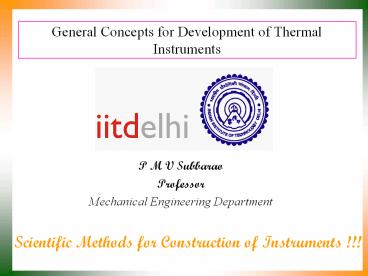General Concepts for Development of Thermal Instruments - PowerPoint PPT Presentation
1 / 20
Title:
General Concepts for Development of Thermal Instruments
Description:
General Concepts for Development of Thermal Instruments P M V Subbarao Professor Mechanical Engineering Department Scientific Methods for Construction of Instruments !!! – PowerPoint PPT presentation
Number of Views:142
Avg rating:3.0/5.0
Title: General Concepts for Development of Thermal Instruments
1
General Concepts for Development of Thermal
Instruments
- P M V Subbarao
- Professor
- Mechanical Engineering Department
Scientific Methods for Construction of
Instruments !!!
2
Definition of An Instrument
- A tool required for quantitative description of a
thermodynamic system. - Capable to reach any one of the following
equilibrium with a system. - Thermal Equilibrium
- Mechanical Equilibrium
- Chemical Equilibrium
3
Basic Steps in Development of Instruments
- Development of Mathematical Model for
Identification of Parameters to be measured. - Identification of characteristics to be
possessed by a general Instruments. - Qualitative and Quantitative models for
determination of Instrument design details. - Selection of geometrical and physical parameters.
4
Theory of Heat
- Written by Maxwell and published first in 1870
- Describes his views of the limitations of the
Second Law of Thermodynamics - Maxwell Relations were first introduced in this
book
5
Why Use Maxwell Relations?
- Certain variables in thermodynamics such as
entropy, are hard to use in practice. - Maxwell relations provide a way to exchange
variables
6
Characterization of Working Fluid
7
Constant Pressure Heating Process
Vapour
Liquid Vapour
h
Liquid
s
8
Constant Pressure Heating Process
s
9
Analysis of Constant Pressure Steam Generation
Specific Specific Specific
Pressure Enthalpy Entropy Temp Volume
MPa kJ/kg kJ/kg/K C m3/kg
1 1 3500 7.79 509.9 0.3588
2 5 3500 7.06 528.4 0.07149
3 10 3500 6.755 549.6 0.03562
4 15 3500 6.582 569 0.02369
5 20 3500 6.461 586.7 0.01776
6 25 3500 6.37 602.9 0.01422
7 30 3500 6.297 617.7 0.01187
8 35 3500 6.235 631.3 0.0102
10
Behavior of Fluid At Increasing Pressures
All these show that the sensitivity of the fluid
increases with increasing pressure.
11
Ideal Rankine Cycle p-h Diagram
3
2
1
4
12
Ideal Rankine Cycle P-h Diagram
13
What are some examples of Maxwell Relations?
14
Using Maxwell Relations
Maxwell Relations can be derived from basic
equations of state, and by using Maxwell
Relations, working equations can be derived and
used when dealing with experimental data.
15
Description of A System
- Description of a system is essential for Thermal
Analysis. - Microscopic Description or Macroscopic
Description. - Microscopic Description
- A System consists of a Substance.
- A collection of atoms or molecules.
- Each Atom can be described by its position,
velocity, mass. - Collective description of atoms is the
description of System. - Each atom requires three equations for the
description of position and three equations for
the description of velocity. - Millions of equations !
- Highly computationally intensive.
- Kinetic Theory and Statistical Mechanics use
Probability Theory. - This is a true description of system but
impractical.
16
Macroscopic Description of A System
- Thermal Engineering uses Macroscopic Description
of a system. - Gross or average effects of many molecules are
described and measured. - These effects are perceived by our senses and
measured by instruments. - This description is the time-averaged influence
of many molecules. - A Virtual Description of a System but truly
practicable.
17
What do we measure to describe a System?
- LENGTH (m)
- AREA (sq. m)
- VOLUME (cu. m)
- TIME (s, min, h)
- VELOCITY (m/s)
- ACCELERATION (m/s2)
- MASS (kg)
- FORCE or WEIGHT (N)
- PRESSURE (kPa, mm of Hg, m of water)
18
Thermodynamic Property
- Any suitable characteristic whose value depends
on the condition of a system and which is
relevant to our thermodynamic study is known as
a Thermodynamic Property. - Primitive Property -- Directly observable -- With
simple experiments -- No change in system. - Derived Property -- Vigorous experiments -- To be
calculated using observations. - Intensive property -- Local property --
Independent of mass or size of the system. - Extensive property -- depends on the extent of
the system -- Obey Colligative Law.
19
Role of A Thermodynamic Property
- Suppose you want to forecast the weather this
weekend in New Delhi. - Identify true characteristics of weather which
can be used to understand and define the state of
weather. - Say Temperature.
- Is the Temperature is a true characteristic of
weather condition. - You construct a formula for the temperature as a
function of several environmental (measurable)
variables. - Now you would like to see how your weather
forecast would change as one particular
environmental factor changes, holding all the
other factors constant. - Will this temperature, truly represent the state
of the weather? - Is the Temperature A Property of Weather?
- To do this investigation, you would use the
concept of a partial derivative...
20
Corollaries on Properties.
- Corollary 1 A change of state is fully described
by means of the initial and final values of all
the primitive properties of the system. - A change occurs when at least one of its
primitive properties changes value. - Corollary 2 A process is required for the
determination of a derived property. - Corollary 3 The change in value of a property
is fixed by the end states of a system undergoing
a change of state and is independent of the path. - Corollary 4 Any quantity which is fixed by the
end states of a process is a property. - Corollary 5 When a system goes through a cycle,
the change in value of any property is zero. - Corollary 6 Any quantity whose change in a cycle
is zero is a property of a system.

